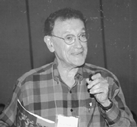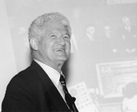"How Did We Get Here Tonight?"
September 6, 2002

Ivar Stakgold reminded the audience of the central role of Delaware in SIAM's creation. Indeed, it was in the state of Delaware that SIAM was formally incorporated, and the University of Delaware gave the Journal of the Society for Industrial and Applied Mathematics its first editors, Robert Jackson and Russell Remage (as well as its 24th president---Stakgold was SIAM president in 1989-90).
For Kuhn, who was to become SIAM's third president (1954-55), it all began in the summer of 1948 when, as a young (pure) mathematician at Princeton, he needed a summer job. Al Tucker, Kuhn explained, was then working on game theory and linear programming; joining in, Kuhn found himself "hooked on it forever."
Kuhn was hooked in another way a few years later---in 1952, Ed Block, then working in Philadelphia, at Philco Corporation, was looking for people who shared his energy and drive to help keep the newly formed SIAM (incorporated on April 30, 1952) moving forward. "Ed was responsible for just about everything in this organization," Kuhn said---even, not surprisingly, "arranging for his boss to become the first SIAM president." That was William Bradley, who held the position for a very short time before resigning (to be able to devote more time to Philco business), to be replaced by Donald Houghton of the Franklin Institute.
A series of well-attended meetings for applied mathematicians in the Philadelphia area (organized and publicized with the support of the remarkably generous Philco) had Kuhn, Block, and others thinking about a wider arena for SIAM activities. For the audience at the retrospective, Kuhn recalled an early collaborative venture of the new society. He had elicited permission from the American Mathematical Society to hold a SIAM meeting in conjunction with a joint meeting of the AMS, the Mathematical Association of America, and the Association for Symbolic Logic. The meeting was held in Pittsburgh, the week between Christmas and New Year's, 1954.
SIAM's program took the form of three invited addresses; the speakers (two of them friends of Kuhn's and, as such, available at no cost) were an impressive debut for SIAM: Brockway Macmillan, who would become assistant secretary of the Air Force and SIAM's seventh president (1959-60), spoke on stochastic processes in the communications industry (an area in which he was working with Bell Labs colleagues Richard Hamming, Claude Shannon, and David Slepian); Herbert Simon, who would go on to receive a Nobel Prize in economics, discussed the control of industrial operations; and Charles Crouse discussed the use of probabilistic methods in the insurance industry.
Justifiably proud of this slate of speakers, Kuhn was determined to take their message beyond the mathematical audience at the meeting. Inviting a group of reporters to his hotel room, he did his best to explain what SIAM was all about, and what the work of the three speakers meant for society at large. Much to his surprise, he read in the next day's newspapers about an AMS/MAA/ASL meeting being held in the city "through the courtesy of SIAM." This turn of events, recounted with considerable charm by Kuhn in his retrospective talk, infuriated then AMS executive director John Curtiss and seemed to put an end to SIAM's hopes of a harmonious relationship with the AMS (that this wasn't the case can be seen in some of the photos of SIAM's 50th Anniversary Meeting!).
Kuhn touched on another monumental early step for SIAM: the birth of the Journal of the Society for Industrial and Applied Mathematics. The first issue, as Kuhn remembers it, was "typed on someone's porch with an electric typewriter." Dated September 1953, it contained four papers---a "nice mixture," Kuhn said, "of cutting-edge topics" of the time. The first editors of JSIAM were Robert Jackson and Russell Remage, both of the Department of Mathematics at the University of Delaware; the managing editor was "the person who did everything"---Ed Block.
(Block himself tells stories of the sometimes extravagant lengths he went to in prying papers out of reluctant authors for the early issues of the journal. From the other perspective is a story from David Young, recounted in Philadelphia during the discussion period that followed the retrospective by a former PhD student of Young's. Having attended a math conference at Columbia University, the story goes, Young was in a crowded New York subway car with Mario Juncosa and Ed Block. On hearing of Block's difficulties in getting papers for JSIAM, Juncosa reached into his inside suit coat pocket, extracted a folded manuscript, and placed it in Block's hand. Titled "On the order of convergence of solutions of a difference equation to a solution of the diffusion equation," it was published in JSIAM, Vol. 1, No. 2, December 1953.)
The first paper in the first issue of JSIAM, actually the first in a series of five on automatic digital computers, captured Kuhn's attention with a reference to companies then known to be "preparing for the commercial production of digital computers ranging in cost from $50,000 to $4,000,000, and in speed from ten operations per second to 5,000 operations per second."
"There is reason to believe," the authors continued, "that ultimately quite good digital computers may be available at $10,000 or less. However, the key to cost is the cost per effective unit operation, and cost of computer is only one factor therein. In many cases the cost of a staff adequate to operate the computer may completely mask the cost of the computer."
By the third issue, Kuhn concluded, the journal had a "real" compositor and printer; he, Phil Davis, and David Young had joined the editorial board, and the journal was on its way to becoming a respected quarterly. Despite the enterprising efforts of Ed Block, however, a steady stream of high-quality papers remained a problem; rescue, and a turning point for the journal, came in 1957, when Don Thomsen promised efficient, speedy processing to participants in a conference on matrix computations, held at Wayne State University, who submitted their papers to JSIAM. The response was overwhelming, and the future of JSIAM was assured, if with a decided numerical analysis slant. The rest---the creation of SIAM Journal on Numerical Analysis not long afterward, soon to be followed by SIAM Journal on Control and Optimization, and the subsequent evolution, divisions, and spinoffs that eventually led to the current list of twelve SIAM journals---is history.



Joining Harold Kuhn as speakers in the Sunday "Retrospective" were Peter Lax (left), Joe Keller (center), and Beresford Parlett (right) . Lax devoted his remarks to John von Neumann, the "patron saint of SIAM." Because "everyone knows that von Neumann was the father of modern computers," Lax focused for the SIAM audience on von Neumann's lesser known role in founding computational fluid dynamics.
A lot of work was done in the field of matrix computations in the early 1950s (Lanczos, Stiefel, Hestenes, David Young, Wallace Givens . . .), Parlett pointed out. SIAM's involvement began in 1957, with the meeting now known as Householder I, organized by Givens (SIAM president, 1968-70) and held at Wayne State University. Papers from the meeting, as mentioned by Kuhn, were published in early issues of SIAM's first journal, giving it the cushion it needed to become a respected quarterly journal of applied mathematics.
Coinciding with the creation of SIAM was the appearance of several academic centers of applied mathematics, Keller pointed out---at Brown, MIT, and soon afterward at Princeton. Keller himself was at NYU, where he would later chair the applied mathematics department---and search journals in an attempt to decide on the mathematics an engineer should know.

